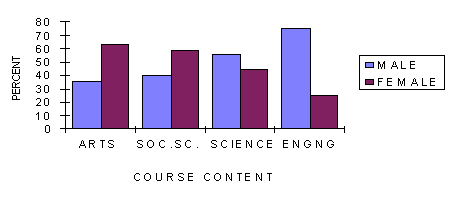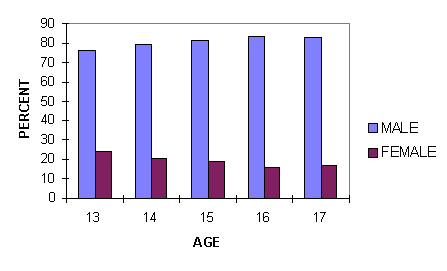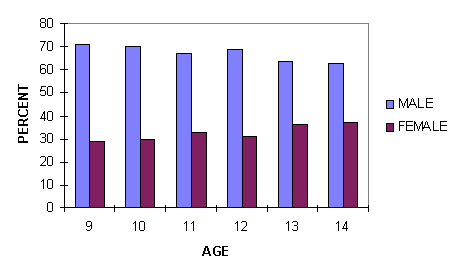
SUMMARY
Female enrolments of under 20% are typical of many undergraduate programmes
in Canadian engineering schools. This limit has been attributed to a gender
barrier. The subject choices of over 13000 children in enrichment mini-university
courses and summer camps are examined. The participation rate of girls
in technological subjects such as engineering, shows the gender barrier
becomes a significant factor as early as age nine.
INTRODUCTION
There is general agreement that efforts should be made to attract more women into engineering[1]. Unfortunately, female enrolments of only 10 to 20% are typical of Canadian engineering schools although in some programmes the numbers are higher. The 10 to 20% limit has been attributed to a gender barrier. Certainly, an examination of children's perceptions of their future found that gender was the most significant variable in determining their responses[2].
The objective of this research was to identify the age at which the gender barrier seriously affects young women.
METHOD
The principal source of data was the Enrichment Mini-Courses Programme
for bright and highly-motivated students from ages 13 to 18[3].
During the 1982 to 1990 period, 163 mini-courses involving 6250 students
were offered at Carleton University. The gender and age of the students
in each course were obtained. The courses were categorized into 4 content
areas: arts, social sciences, science and engineering. The engineering
category included technologically-based disciplines such as architecture,
industrial design and computer programming. In all cases the participants
had a free choice of subject area.
Additional data for 6967 children between 9 and 15 years of
age were obtained from 4 university sites, each in a different province.
Carleton University, University of Calgary, University of Manitoba and
Simon Fraser University run children's summer camps which combine athletic
and academic modules. Data were obtained for the period covering 1987 to
1990. Some sites provided data for only a portion of this period. Gender
and age, where available, were obtained for each of the sites. The children
chose academic modules with 4 or 5 components. The engineering content
ranged from 0 to 50%.
SPSSX[4], was used to analyse the age, course content and gender data for the mini-courses and children's camps.
RESULTS
In the mini-courses, a chi-squared test showed a significant effect
of content area on gender ratio. The ratios of enrolment differed across
content areas with engineering having the lowest female enrolment. The
overall percentage of female students enrolled in all mini-courses was
50.5%. Arts had a female enrolment of 62.9% and social sciences had a female
enrolment of $60.2%. Science and engineering had significantly lower female
enrolments of 38.5% and 20.2% respectively. Although this study is directed
at engineering, the low female enrolment in science should also be a concern.
Figure 1 shows the gender ratio by content area for age 13. The same pattern
was found at every age level examined.

Fig. 1 Gender ratio for mini-course enrolment for age 13, sample size: 2087.
Surprisingly, age had no significant effect on gender ratio in any of
the content areas. This is of particular importance in engineering where
female enrolment was as low as 24.3% at age 13. Figure 2 shows the gender
ratios for engineering. Although there is a slight downward trend with
increasing age, there is no significant change. The gender barrier, in
terms of the enrichment mini-courses, is in existence by age 13.
The data from the children's camps were less easily analysed due to
their diverse nature. For example, ages were available only from Carleton
and Manitoba. There was a marked variability among the sites and the low
student numbers in some modules made interpretation more difficult. It
should also be noted that the students' selection of courses was more limited
than in the mini-courses. Parental guidance, which can contribute to a
gender barrier, may play a larger role in the students' choices, especially
for the younger children.

Fig. 2 Gender ratio for mini-courses enrolment in engineering,
sample size: 1031.
A chi-squared test on the overall gender ratio showed a significant site effect. Over the entire age range of 9 to 15 the relationship between engineering content and gender ratio, as shown in Figure 3, was significant at Carleton University, University of Manitoba and University of Calgary but, for unknown reasons, not at Simon Fraser University. Carleton and Calgary show a monotonic decline with increasing engineering content. At Manitoba, where the sample size is larger, the decline occurred for engineering contents between 20 and 40%.

Fig. 3 Female enrolment at children's camps, sample size: 6967.
Although the low number of students, only 387, may make the data inconclusive, Carleton's camps show a significant engineering content effect at ages 11 and 12. The larger sample size at University of Manitoba made it possible to examine the age effect at that site. The effect of engineering content was significant at every age level. In Figure 5 the percentage female enrolment for an engineering content of 40% is shown. Although there is a slight increase at ages 13 and 14, female enrolment is as low as 30% as early as age 9.

Fig. 4 Gender ratio for University of Manitoba children's camp for 40% engineering content, sample size: 758
CONTRIBUTIONS AND CONCLUSIONS
This research shows that the gender barrier becomes a significant factor in the lives of girls as early as age 9 and is firmly in place by age 13. Efforts to address low enrolment of women in subjects such as engineering often target women between the ages of 16 and 18; e.g.,[5]. The authors feel that programmes aimed at these women may add to the numbers in engineering at the expense of the science subjects, which also suffer from low female enroloment. Clearly, to increase the number of women in technologically-based programmes, society must remove a gender barrier that affects girls in their early school years. It is the authors' opinion that programmes to alleviate this gender barrier should be geared to the needs of children younger than age nine.
ACKNOWLEDGEMENTS
The financial support of Carleton University (GR-5) and the assistance of the Carleton University, University of Calgary, University of Manitoba and Simon Fraser University are gratefully acknowledged.
REFERENCES
[1] F. Tavenas, NSERC Seminar on Canada's Future Requirements for Highly Qualified Scientists and Engineers, contribution to the discussion, Ottawa, May 3, 1990.
[2] When I Grow Up ... Career Expectations and Aspirations of Canadian Children, Women's Bureau of Labour Canada, Ottawa, 1986.
[3] The Enrichment Mini-Course Programme - A Success Story, Service for Continuing Education, University of Ottawa, Ottawa, April 1990.
[4] SPSSX Statistical Package for Social Sciences, 3.1, SPSS Inc., Chicago, 1989.
[5] Science and Engineering: Where are the Women, Briefing Notes, Council of Ontario Universities, 38, February, 1989.